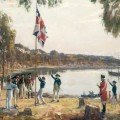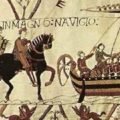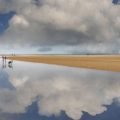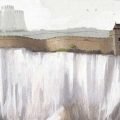
The political union of 1707 had been preceded by a natural one over 400 million years earlier. England was attached to a small continent called Avalonia, drifting northwards across the ocean. At the same time, several thousand kilometres away, Scotland was heading south as part of the Laurentia continent. It was a slow-motion crash of continents which took place pretty much along the line where, somewhat later, in 122 CE the Roman emperor Hadrian would build a wall. This north-south collision failed to create mountains but did result in the Cheviot Hills, which run along the English-Scottish border. Fast-forward past rainforests, dinosaurs and mammoths, and eventually, about 800,000 years ago, humans show up. Then it gets cold again, so they leave, and come back, and leave, and repeat the process until it gets warm enough to stay.
In about 10,000 BCE, Ireland was separated from Britain by rising sea levels which also flooded the land between what is now Britain and Continental Europe, making Britain an island. To be more accurate, Britain is made up of islands – thousands of them if you count by size and what is above water at high tide; but of these only around 200 are inhabited. The United Kingdom of Great Britain and Northern Ireland includes the Hebrides, Orkney and Shetland Islands to the far north, the Isles of Scilly and Isle of Wight 1,000 kilometres to their south, and the island of Anglesey, off the Welsh coast, to the west. It has direct access into the English Channel, the North Sea, the Irish Sea and the Atlantic. At its widest it is only 500 kilometres across, and because of its jagged coastline no part is more than 120 kilometres from the sea.
The first records of its existence came around 330 BCE, when a Greek explorer named Pytheas made an astonishing voyage north, possibly as far as Iceland, and along the way circumnavigated what we now know is Britain. He wasn’t believed by everyone, but that’s because he also returned with stories of white bears sitting on ice caps and the sun shining at midnight.
The rough, cold waters of the North Sea are not for me, and so when, a few years ago, I decided to explore Europe’s largest island I did so on two wheels, cycling its length on the route known as ‘LEJOG’ – Land’s End to John O’Groats. It’s 1,600 kilometres long, and usually done from south to north as you have a better chance of having the wind at your back. It took twelve days, each one a painful joy. What struck me more than anything was how much, at the end of each day, the accents, dialects and type of place names had changed. Even over as little as 50 kilometres there are marked differences. This is due to both geography and history. The regions developed in relative isolation, and were influenced by the arrival of Romans, Anglo-Saxons, Vikings and Normans. For example, the Scandinavians settled in what is now called East Anglia; the suffix ‘-by’ is though to originate from the Danish word for ‘town’, and this explains why names such as Whitby and Grimsby are found on the east coast of England. To this day, in Yorkshire words someone from the south might not even understand are spoken daily – ‘bairn’ for child and ‘beck’ for stream, for example. Most countries have regional differences, but few are as pronounced over such small areas as those of the UK.








Theres an error in this. “At its widest it is only 500 kilometres across, and because of its jagged coastline no part is less than 120 kilometres from the sea.” This should state ‘no part is more than 120 km from the sea.’
Thanks Arion, and well spotted! I’ve updated it now, cheers!